Hydro One Bundle
Who Really Owns Hydro One?
Understanding who owns a company is fundamental to grasping its strategic direction and potential for growth. This is especially true for a vital utility like Hydro One, Ontario's largest electricity transmission and distribution company. From its roots over a century ago, Hydro One has undergone a significant transformation in its ownership structure. This exploration will uncover the key players and the evolution of Hydro One SWOT Analysis ownership.
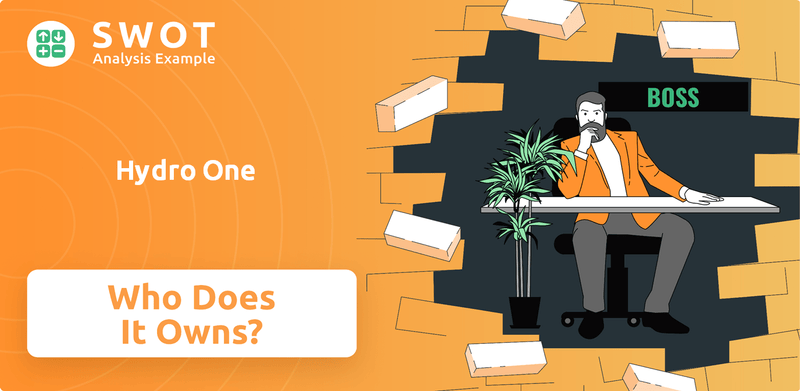
The shift in Hydro One's ownership, from a Crown corporation to a publicly traded entity, has reshaped its governance and operational landscape. This analysis will explore the intricacies of Hydro One ownership, examining its shareholders, and financial performance to provide a comprehensive understanding of this critical infrastructure provider. Discover the answers to questions like "Who owns Hydro One?" and "Who is the majority owner of Hydro One?" as we delve into the details of Hydro One ownership structure and its impact on the market.
Who Founded Hydro One?
The story of Hydro One's ownership begins with its roots in public service. Initially, it was established as part of the Hydro-Electric Power Commission of Ontario (HEPC) back in 1906. This entity was created to manage the province's electricity infrastructure, with the goal of providing affordable and accessible power to the people of Ontario.
Adam Beck, a key figure in the provincial government, played a crucial role as the first chairman of the HEPC. His vision was centered on a publicly owned electricity grid, reflecting a commitment to public control over a vital resource. This early structure laid the foundation for what would eventually become Hydro One.
The initial ownership of what would become Hydro One was entirely public. The Government of Ontario, acting on behalf of its citizens, held 100% equity in the entity. This meant there were no individual founders or private investors with specific shareholdings. The focus was on public service and ensuring that electricity was available and affordable across the province.
Hydro One's origins are firmly in public ownership, starting with the Hydro-Electric Power Commission of Ontario (HEPC) in 1906.
Adam Beck, the first chairman, championed a publicly owned electricity grid.
The Government of Ontario held 100% equity, ensuring public control and no private shareholders initially.
The entity was designed as a public utility, focusing on access and affordability.
There were no initial ownership disputes or private shareholdings, as it was a public entity.
In 1999, Ontario Hydro was reorganized, with Hydro One emerging as a corporation.
In April 1999, Ontario Hydro was restructured. Hydro One was established as a corporation under the Business Corporations Act. Even in its new corporate form, the Government of Ontario remained the sole shareholder. This transition set the stage for future changes in the Hydro One ownership structure, but initially, it maintained the legacy of complete government ownership. This is important to understand when examining the
Hydro One's early ownership was entirely public, rooted in the Hydro-Electric Power Commission of Ontario.
- The Government of Ontario was the sole shareholder.
- Adam Beck's vision emphasized public control.
- The focus was on providing affordable electricity.
- The company transitioned into a corporate structure while maintaining government ownership initially.
Hydro One SWOT Analysis
- Complete SWOT Breakdown
- Fully Customizable
- Editable in Excel & Word
- Professional Formatting
- Investor-Ready Format
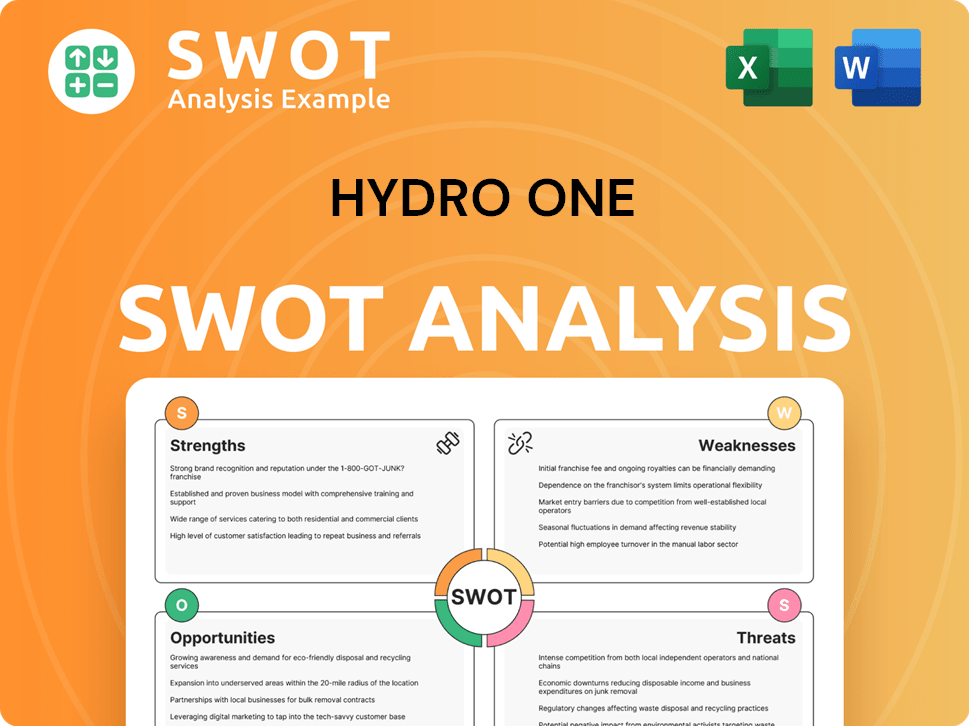
How Has Hydro One’s Ownership Changed Over Time?
The evolution of Hydro One's ownership reflects a significant shift from complete government control to a publicly traded model. Initially, as the Hydro-Electric Power Commission of Ontario (HEPC) and later Ontario Hydro, the Province of Ontario held exclusive ownership. This changed dramatically with the partial privatization, marking a pivotal moment in the company's history.
The Initial Public Offering (IPO) on November 5, 2015, was a landmark event. Hydro One Limited issued 81.1 million common shares at $20.50 per share on the Toronto Stock Exchange, raising approximately $1.66 billion. This was the largest IPO in Canada since 2000. The Province of Ontario aimed to reduce its stake to 40% over time. Subsequent share offerings in 2016 and 2017 further diluted the province's holdings, reshaping the ownership structure.
| Date | Event | Impact on Ownership |
|---|---|---|
| 1906 | Establishment of HEPC | Province of Ontario as sole owner |
| November 5, 2015 | Hydro One IPO | Partial privatization; introduction of public shareholders |
| 2016-2017 | Secondary Share Offerings | Further reduction of the Province's stake |
| January 2018 | Sale to OFN Power Holdings | First Nations partnership acquires shares |
| May 9, 2025 | Institutional Holdings | Vanguard and JPMorgan hold over 20 million shares |
As of September 30, 2021, the Province of Ontario held approximately 47.2% of Hydro One's common shares, including 47.4% directly and 1.5% through Ontario Power Generation. While still the largest shareholder, the government no longer maintains a majority stake. Other significant stakeholders include institutional investors and retail shareholders. In January 2018, OFN Power Holdings, a partnership controlled by 129 First Nations, acquired over 14 million shares, representing 2.4% of outstanding common shares. As of May 9, 2025, institutional owners, such as Vanguard and JPMorgan, collectively held over 20 million shares. These changes have introduced a greater emphasis on financial performance and returns, alongside the company's public service responsibilities. The shifts in Hydro One ownership have transformed its governance and strategic focus.
Hydro One's ownership structure has evolved significantly, from a fully government-owned entity to a publicly traded company.
- The Province of Ontario remains a significant shareholder but no longer holds a majority stake.
- Institutional investors and First Nations partnerships now hold substantial portions of Hydro One shares.
- The shift has introduced a greater focus on financial performance alongside public service.
- Understanding Hydro One's ownership is crucial for investors and stakeholders.
Hydro One PESTLE Analysis
- Covers All 6 PESTLE Categories
- No Research Needed – Save Hours of Work
- Built by Experts, Trusted by Consultants
- Instant Download, Ready to Use
- 100% Editable, Fully Customizable
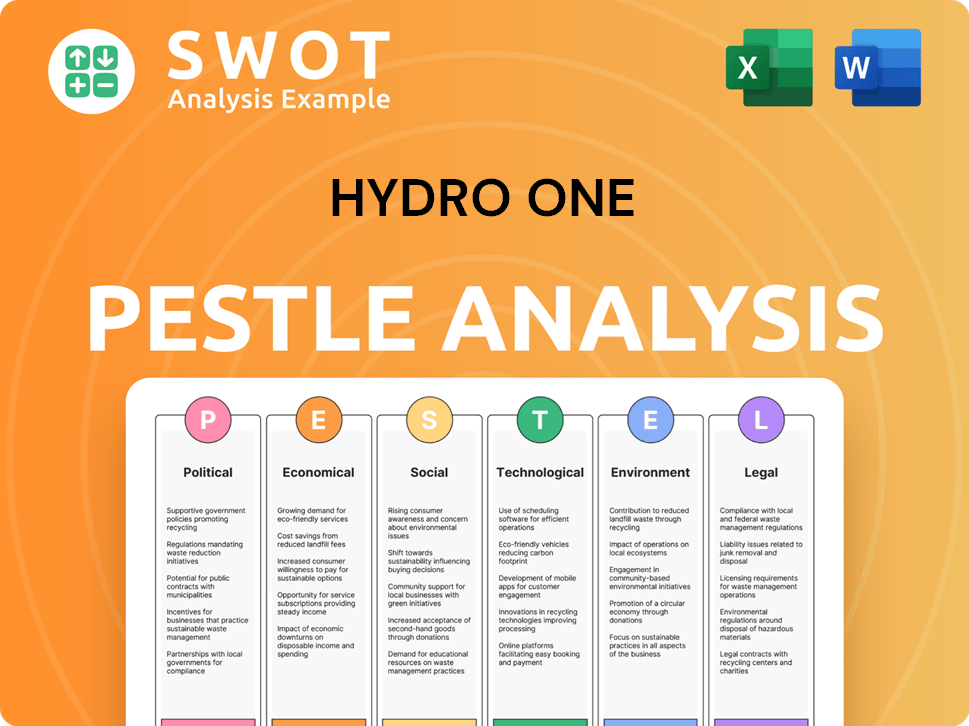
Who Sits on Hydro One’s Board?
The independent Board of Directors at Hydro One oversees the company's operations and strategic decisions. The composition of the board reflects the mixed ownership structure of the company. As of June 10, 2024, the board comprises 11 directors, with 10 considered independent. This structure is designed to ensure effective oversight, balancing the interests of all stakeholders. The board's independence is crucial for making unbiased decisions and maintaining the company's integrity.
The governance agreement between Hydro One and the Province of Ontario, the largest shareholder, outlines specific authorities for the government. The government can nominate 40% of the board members. Moreover, the government has the power to remove all board members, except the chair, who can be removed at the government's discretion. Board nominees must meet set qualifications, including independence, commercial experience, and expertise. This balance of power helps to ensure both accountability and strategic alignment.
| Director | Role | Independence |
|---|---|---|
| Tim Hodgson | Chair of the Board | Independent |
| William Sheffield | Director | Independent |
| Joanne Shoveller | Director | Independent |
Hydro One's voting structure generally follows a one-share-one-vote principle for common shares listed on the Toronto Stock Exchange under the symbol 'H'. The Province of Ontario holds a significant stake, approximately 47.2% of common shares as of September 30, 2021, which, combined with the governance agreement, gives the government considerable influence. Recent updates to the executive compensation framework in 2024 suggest a move towards a more balanced decision-making process, benefiting all stakeholders. For more insights, consider exploring the Growth Strategy of Hydro One.
The board of directors at Hydro One is independent, ensuring unbiased oversight. The Province of Ontario, the largest shareholder, has significant influence through its stake and governance agreement. The company's governance structure is evolving to balance stakeholder interests.
- Hydro One's board is primarily independent.
- The Province of Ontario is the largest shareholder.
- The governance structure is designed for balance.
Hydro One Business Model Canvas
- Complete 9-Block Business Model Canvas
- Effortlessly Communicate Your Business Strategy
- Investor-Ready BMC Format
- 100% Editable and Customizable
- Clear and Structured Layout
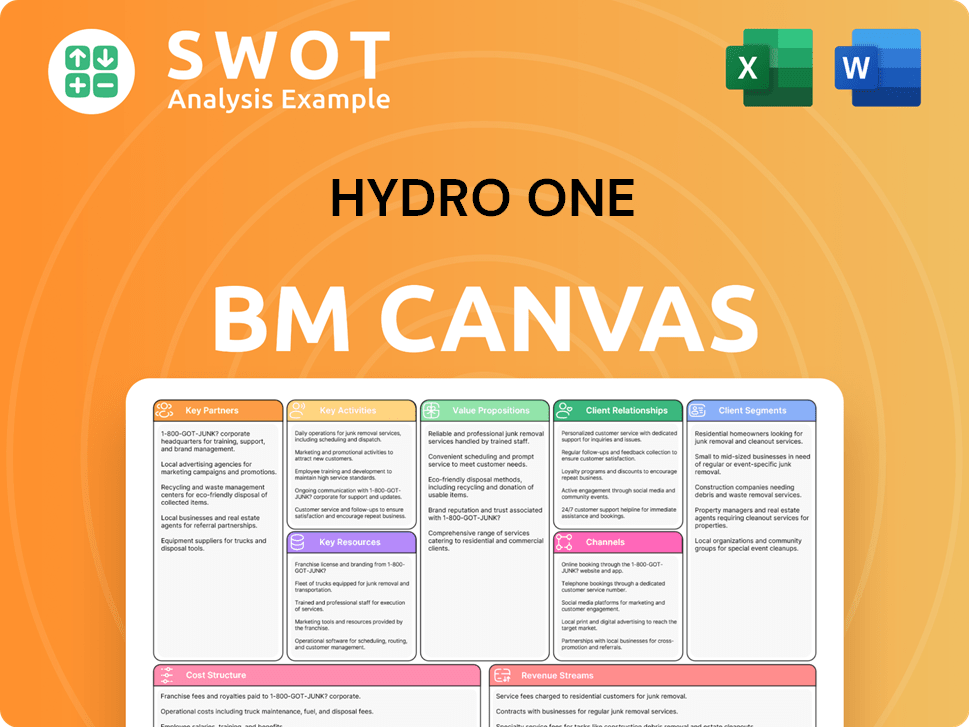
What Recent Changes Have Shaped Hydro One’s Ownership Landscape?
Over the past few years, Hydro One's ownership has remained a key focus, with strategic growth initiatives continuing. As of December 31, 2024, the company reported assets of $36.7 billion and generated $8.5 billion in annual revenues during 2024. A significant investment of $3.1 billion was made in its transmission and distribution networks that year. In the first quarter of 2025, Hydro One showed strong financial performance, with net income attributable to common shareholders reaching $358 million, an increase from $293 million in the same period of 2024. Earnings per share (EPS) also rose to $0.60 from $0.49. Revenues for the first quarter of 2025 were $2,408 million, a notable increase of $242 million compared to the first quarter of 2024.
A recent development in Hydro One ownership is the acquisition of a 48% interest in the East-West Tie Limited Partnership, completed in March 2025, for CAD 261 million. This expands its transmission ownership and creates partnerships with the Bamkushwada Limited Partnership and affiliates of NextEra Energy Canada, LP. These moves reflect a strategic approach to expanding its infrastructure portfolio and managing its ownership structure.
| Metric | 2024 | Q1 2025 |
|---|---|---|
| Assets (billions) | $36.7 | N/A |
| Annual Revenues (billions) | $8.5 | $2.408 |
| Net Income (millions) | N/A | $358 |
| EPS | N/A | $0.60 |
The ownership of Hydro One also reflects broader industry trends. Institutional ownership is increasing, with 159 institutional owners holding a total of 20,585,166 shares as of May 9, 2025. Major institutional shareholders include Vanguard Total International Stock Index Fund and JPMorgan BetaBuilders Canada ETF. While the Province of Ontario remains a significant shareholder, holding approximately 47.11% as of September 30, 2021, the company's focus on a regulated growth strategy is aligned with stakeholder interests. Hydro One plans to invest approximately CAD 15 billion between 2024 and 2028, primarily in regulated transmission and distribution projects, signaling a stable outlook for its ownership structure and a commitment to growing its regulated asset base.
Hydro One is a publicly traded company with a hybrid ownership model. The Province of Ontario is a major shareholder, alongside institutional and retail investors. This structure balances public and private interests.
Significant institutional shareholders include Vanguard and JPMorgan. The Province of Ontario remains a key stakeholder, ensuring public oversight and involvement in the company's operations.
Recent acquisitions, such as the stake in the East-West Tie Limited Partnership, demonstrate Hydro One's strategic expansion. These moves enhance its transmission infrastructure and partnerships.
Strong financial results in Q1 2025, including increased net income and revenue, reflect the company's growth and operational efficiency. The company is focused on regulated growth.
Hydro One Porter's Five Forces Analysis
- Covers All 5 Competitive Forces in Detail
- Structured for Consultants, Students, and Founders
- 100% Editable in Microsoft Word & Excel
- Instant Digital Download – Use Immediately
- Compatible with Mac & PC – Fully Unlocked
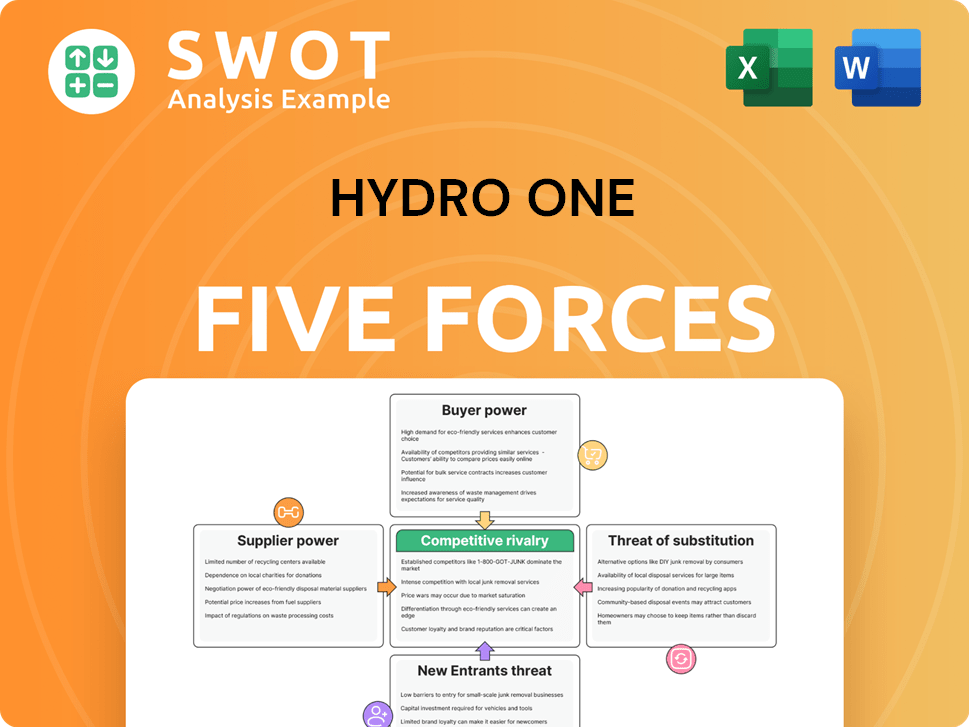
Related Blogs
- What are Mission Vision & Core Values of Hydro One Company?
- What is Competitive Landscape of Hydro One Company?
- What is Growth Strategy and Future Prospects of Hydro One Company?
- How Does Hydro One Company Work?
- What is Sales and Marketing Strategy of Hydro One Company?
- What is Brief History of Hydro One Company?
- What is Customer Demographics and Target Market of Hydro One Company?
Disclaimer
All information, articles, and product details provided on this website are for general informational and educational purposes only. We do not claim any ownership over, nor do we intend to infringe upon, any trademarks, copyrights, logos, brand names, or other intellectual property mentioned or depicted on this site. Such intellectual property remains the property of its respective owners, and any references here are made solely for identification or informational purposes, without implying any affiliation, endorsement, or partnership.
We make no representations or warranties, express or implied, regarding the accuracy, completeness, or suitability of any content or products presented. Nothing on this website should be construed as legal, tax, investment, financial, medical, or other professional advice. In addition, no part of this site—including articles or product references—constitutes a solicitation, recommendation, endorsement, advertisement, or offer to buy or sell any securities, franchises, or other financial instruments, particularly in jurisdictions where such activity would be unlawful.
All content is of a general nature and may not address the specific circumstances of any individual or entity. It is not a substitute for professional advice or services. Any actions you take based on the information provided here are strictly at your own risk. You accept full responsibility for any decisions or outcomes arising from your use of this website and agree to release us from any liability in connection with your use of, or reliance upon, the content or products found herein.